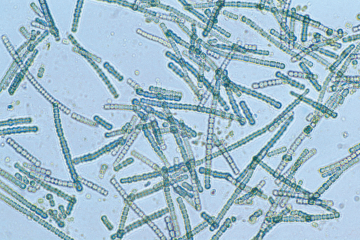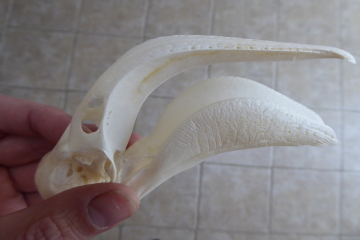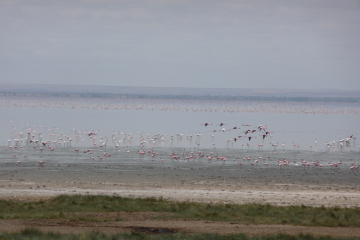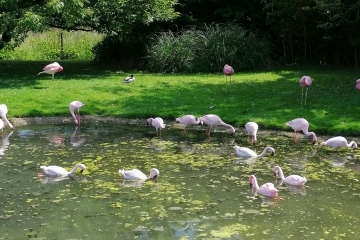Ancient dinners for ancient birds
No doubt avid readers of the WWT Flamingos Diary are familiar with the filtering behaviour, and unique bill anatomy, that all six species of flamingo use to collect their food. These bill and behavioural adaptations allow flamingos to inhabit extreme wetlands and to collect food that other species of animals cannot access. And some of these favourite flamingo foods are vitally important to our understanding of the history and formation of Planet Earth itself.
Viewers of the BBC’s new ground-breaking nature documentary series Frozen Planet II may recall the exploration of a frozen lake on the eastern edge of Antarctica that revealed the presence of living organisms living on the floor of the lake, deep below its frozen surface. These organisms, called giant stromatolites are some half-a-metre tall and are created by the oldest, and perhaps most important, living organisms on the planet – Cyanobacteria, commonly known as blue-green algae.

Above: A microscope view of a flamingo's favourite food. Blue-green algae, Cyanobacteria. The oldest living things on earth. Photo: cc 3.0 licence, Wikimedia Commons.
Cyanobacteria are the most prehistoric of all living things. Scientists have dated their evolution to somewhere between 3.4 to 2.9 billion years ago. They are single-celled organisms that can live in fresh or saltwater and are found in water bodies all around the world. Cyanobacteria use sunlight to generate energy- they photosynthesise in the same way that plants and trees do, and a by-product of photosynthesise is oxygen. Therefore, cyanobacteria are ultimately responsible for changing the atmosphere of the brand-new Planet Earth that allowed other, more complex plants and animals to evolve. Like the ducks, geese, swans, otters, and flamingos you can see at WWT centres today.
So, what does any of this have to do with flamingos? Especially because there are no flamingos in Antarctica! Three species of flamingo, with the densest and tightly packed filtering materials (lamellae) inside their bills are known as “deep-keeled flamingos”. These are the Andean, puna (James’s) and lesser flamingos, and they can filter for and eat blue-green algae. The lesser flamingo in particular is a blue-green algae specialist. It has the most densely packed filtering lamellae of all flamingos and is the most efficient at collecting these microscopic floating prehistoric cyanobacteria.

Above: The bill of a lesser flamingo. Perfectly adapted for filtering out tiny micro-organisms, like blue-green algae. The deep curve of the bill allows for a dense attachment of filtering bristles that act like a sieve.
The lesser flamingo inhabits prehistoric wetlands of its own and these wetlands are brimming with blue-green algae. The Rift Valley Lakes of East Africa are around 35 million years old. Mineral rich hot springs and volcanic activity have caused many of these lakes to be very caustic wetlands (highly alkaline water), that are perfect environments for salt-loving microorganisms to proliferate. Lesser flamingos flock in huge numbers (sometimes millions) to feed on the cyanobacteria that bloom throughout the Rift Valley soda lakes.

Above: Wild lesser (and greater) flamingos in an East African soda lake in the Rift Valley. The perfect home for blue-green algae (and therefore flamingos).
So high are the concentrations of cyanobacteria in some flamingo-filled soda lakes that the pigments these aquatic algae contain, which help them photosynthesise, stain the waters of the lakes bright red. As are the flamingos stained pink by the carotenoid pigments of the blue-green algae they consume, so the lakes waters can appear flamingo coloured too. This shows the intricate and important relationship between the prehistoric wetlands, the prehistoric algae and the highly evolved flamingos that can live and feed in these habitats.

Above: Tasty blooms of algae and duckweed allow our lesser flamingos at WWT Slimbridge filter feed in the same way as their wild cousins. Don't worry about green water or algae in the flamingos' pools. The birds love it!
Hopefully, this has explained the amazing link between the oldest living organisms on the planet and the flamingos, some of the oldest types of birds (with ancestors first noted in the fossil record around 30 million years ago). We are incredibly fortunate to have lesser flamingos at WWT Slimbridge, an uncommon species in zoological collections. Our birds are aged now, but still demonstrate the beautiful adaptations to their environment. Pay them a closer look on your next visit.



